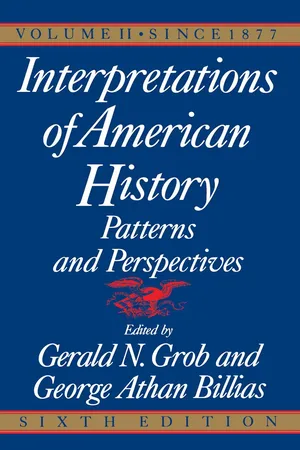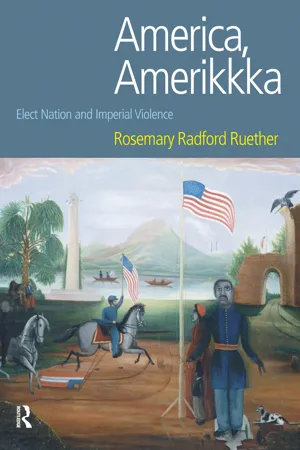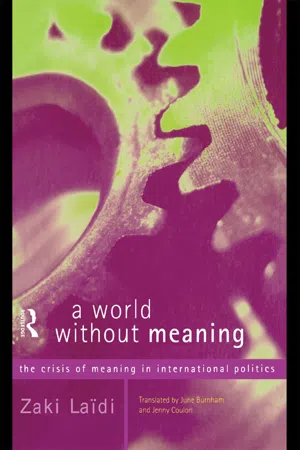History
America in the Cold War
The Cold War was a period of geopolitical tension between the United States and the Soviet Union from the end of World War II until the early 1990s. America played a central role in the Cold War, engaging in a variety of strategies to contain the spread of communism and promote its own interests. This era was characterized by intense political, military, and ideological rivalry between the two superpowers.
Written by Perlego with AI-assistance
Related key terms
5 Key excerpts on "America in the Cold War"
- eBook - ePub
- Gerald N. Grob, George Athan Billias(Authors)
- 2010(Publication Date)
- Free Press(Publisher)
Most historians, but by no means all, agreed that World War II created the setting for the Soviet-American confrontation. Although ideological differences existed between the two great powers prior to that time the war produced suspicion, distrust, and a gap in understanding that became increasingly difficult to bridge. The Cold War, most scholars and laymen concluded, arose from two seemingly incompatible conceptions of the ideal shape of the postwar world order. The American point of view pictured the Soviet Union as a ruthless power, driven by its communist ideology, bent upon global revolution and domination, and headed by leaders like Stalin who embarked upon an aggressive policy of expansion with the ultimate aim of destroying the free world. From Russia’s perspective, however, America represented the main threat to peace. The Soviet view was that the United States emerged from the war militantly committed to the idea of a capitalist world order. America, as an imperalist power, sought to encircle the Soviet Union with hostile capitalist countries, to isolate Russia from the rest of the world, and to destroy communist regimes wherever they existed. Thus the free world and communist camp each viewed the other side as being dedicated to its destruction.American scholars disagreed, however, when they came to evaluate the causes of the Cold War and to pass judgment on the roles of the two adversaries. Since 1945 American historians, when inquiring into the origins of the Cold War, divided into three schools: the orthodox, or traditional school; the revisionists; and the realists. Although the arguments of each school changed somewhat with the passing of time and appearance of new developments, they established the framework of the important historiographical debate that took place.The first to appear was the orthodox school, which came into being during the immediate postwar years. At the time most of the American people, and the vast majority of scholars, were inclined to accept the official explanation of events set forth by the Truman administration in justifying its foreign policy. According to the orthodox interpretation Soviet aggression and expansionist desires were primarily responsible for the coming of the Cold War. - eBook - ePub
America, Amerikkka
Elect Nation and Imperial Violence
- Rosemary Radford Ruether(Author)
- 2014(Publication Date)
- Routledge(Publisher)
America's Global Mission: The Cold War Era, 1945-89
DOI: 10.4324/9781315711201-6For more than forty years two rival empires, identified with two rival ideologies, confronted one another across bristling shields of deadly weapons capable of destroying the peoples of the earth many times over. Each defined themselves in messianic terms as saviors of the world’s peoples against a deadly foe. The U.S. saw itself as the leader of the ‘free world,’ champion of freedom and democracy, against an evil system of totalitarian repression and slavery. The Soviets saw themselves as the leader of an ‘inevitable’ process of world transformation from capitalist exploitation of the workers to socialist equality, over against a United States that had taken up the banner of European imperialism at a time when that system was dying.Stages in the Cold War
The period from 1945 to 1989 was not one of uniform hostility. It took several years after the end of the Second World War for the wartime alliance of the U.S. and Western Europe with the Soviet Union to be redefined as one of unrelenting antagonism. After the death of Stalin in 1953 until the late sixties there was some relaxing of tensions followed by renewed periods of hostility. The period from 1969–1979 was one of détente in which both sides pursued negotiations to resolve major issues of dispute, particularly the nuclear arms race. SALT I, (Strategic Arms Limitation Treaty) signed by President Nixon and Soviet leader Brezhnev in 1972, ended the race to develop defensive antiballistic missile systems (AMBs) and froze the number of nuclear missiles to 1,600 on the Soviet side and 1,054 on the U.S. side. This agreement actually left the U.S. two to one ahead, since the U.S. MIRVs (multiple independently targeted reentry vehicles) contained multiple warheads on one missile capable of hitting widely separated areas.11 Walter LaFeber, America, Russia and the Cold War, 1945–1992 - eBook - ePub
A World Without Meaning
The Crisis of Meaning in International Politics
- Zaki Laidi(Author)
- 2005(Publication Date)
- Routledge(Publisher)
1The meaning of the Cold WarThe more the Cold War fades into the distance, the more we shall be obliged to think of it, re-read it and reinterpret it not only geopolitically but also in cultural terms. We shall discover—doubtless risking over-rationalization of the past— how original this moment in history was in the way it was able, over an exceptionally long period, to reorder the main world issues around a battle for the appropriation of meaning. Within half a century the Cold War managed to ‘encompass’ very large-scale political, economic, social and cultural transformations: the decolonization of the Third World, the growth in economic power of Japan and Germany, the Sino-Soviet split, and the proliferation of bloody regional conflicts. It also managed to incorporate economic and sociological realities as fundamental as the decline of the industrialization strategy to the advantage of the service sector, the erosion of the Keynesian model, the blossoming of individualist values, the development of mass culture and the subsequent atomization of demands.1A ‘tragic system’
But this ‘moment in history’ was not restricted to channelling the shifts in world power or conscientiously fanning regional conflicts. It enabled the pursuit, strengthening and perhaps completion of the long, slow, linear process of the historical transfer of meaning that, over the centuries, had fixed itself in succession on religion, nationalism and finally ideology, that great ‘mythogenous’ factor of the twentieth century.2 Indeed, it managed to combine two absolutes: meaning, symbolized by the ideological combat between two universal and competing value-systems; and power, carried by the absolute weapon, the nuclear bomb.Between 1917 and 1945, all the seeds of an ideological confronta tion had unquestionably been sown. At the same time as the Bolsheviks were seizing the Winter Palace, the American president, Woodrow Wilson, was already drafting the contours of a new order that could raise aloft the flag of democracy in the world.3 - eBook - ePub
- John Rees(Author)
- 2006(Publication Date)
- Routledge(Publisher)
1 Arms and America
The shock to the international state system caused by the collapse of the Eastern bloc in 1989 is a root cause of the instability now endemic in global politics. The bi-polar architecture of the Cold War world fixed all power relations in their place from the Second World War until the East European revolutions. The US is now attempting to create a new imperial order, but the process is contested and dangerous.This is a seismic shift in the landscape of world politics. If we were to reach for historical parallels then only the rise of European colonialism up to the First World War or the fall of the Iron Curtain across Europe after the Second World War would be appropriate in scale and consequence. To fully grasp this enormity a review of Cold War imperial rivalry is necessary.The Cold War
The United States emerged from the Second World War as the only major power whose civilian economy had grown at the same time as its military economy. In every other combatant nation, Allied or Axis, the civilian economy had been ravaged for the sake of waging war. The US penetration of the global market advanced at the cost of enemies and allies alike everywhere from the Far East to the European heartlands of capitalism. As direct European colonial administration gave way to the wave of national liberation struggles and the emergence of independent states in the Third World, so US-led military alliances, client states and economic domination replaced them in many parts of the globe.The exception, and it was a huge exception, was in Russia itself and those areas of Eastern Europe where the Nazis had been driven out by force of Russian arms. At Yalta and subsequent conferences this military reality became an agreed division of Europe by the major powers. After the 1949 revolution China also fell beyond the direct reach of the western military and western corporations. - eBook - ePub
War, Peace and International Relations
An introduction to strategic history
- Colin S. Gray(Author)
- 2013(Publication Date)
- Routledge(Publisher)
Why was it so difficult for the West to make peace with the Soviet Union (and vice versa)? Why did the Cold War endure for more than forty years? One could cite geopolitical rivalry, the key roles of individuals, and contingency, but pride of place needs to be accorded to ideology. The evidence strongly suggests that the Cold War could not end until the Soviet Union abandoned a state ideology which mandated definition of capitalist powers as enemies. When Gorbachev retired the ideology, the Cold War was over. Unfortunately for him, though, the abrupt retirement of Marxism to the dustbin of history also removed the basis for the legitimacy of the Soviet state. It may be worth noting that, at the time of writing (slightly more than a decade into the twenty-first century), the People's Republic of China has not renounced its legitimizing political ideology, yet that legacy (or burden) from the past is not a noteworthy player in contemporary Sino-American security relations. The master narrative of global international relations has to accommodate significant variations from historical case to case.The story now must turn to consider explicitly the meaning of the nuclear discovery and the implications of the subsequent strategic revolution.Key points- Cold War history is hotly contested today.
- World War II had revolutionary consequences for all the contexts of international relations.
- The Cold War emerged slowly, by a process of interaction between rivals, from 1944 until 1947, or even 1950 (the war in Korea).
- Because of geopolitics, ideology and personality (especially Stalin's), the conflict was unavoidable.
- The Soviet Union was fatally outclassed in economic strength by the United States.
- Although it was inevitable that the Soviet Union would lose the competition, it was not inevitable that it would accept such defeat peacefully.
Questions- Who or what caused the Cold War?
- Why did the Cold War last for forty years?
- Why did the Cold War not conclude with World War III?
- Did the Soviet Union expire mainly for internal reasons or was external pressure an important factor?
Further reading
G. S. Barrass, The Great Cold War: A Journey through the Hall of Mirrors (Stanford, CA: Stanford University Press, 2009).R. Crockatt, The Fifty Years War: The United States and the Soviet Union in World Politics, 1941–1991
Learn about this page
Index pages curate the most relevant extracts from our library of academic textbooks. They’ve been created using an in-house natural language model (NLM), each adding context and meaning to key research topics.




